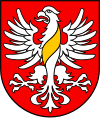
Alternate names: Wiżajny [Pol], Vizhon, ויזאיני [Yid], Vizhainy, Вижайны [Rus], Vižainis [Lith], Vizhan, Wizuny. 54°22' N, 22°51' E, 19 miles N of Suwałki (Suvalk), near the border with Lithuania. Jewish population: 1,172 (in 1867), 332 (in 1921). Gmina Wiżajny is a rural administrative district in Suwałki powiat, Podlaskie Voivodeship in NE Poland on the Lithuanian border with its seat in the village of Wiżajny, 143 km (89 mi) north of the regional capital Białystok. The gmina 2006 total population was 2,672. Gmina Wiżajny contains the villages and settlements of Antosin, Bolcie, Burniszki, Cisówek, Dziadówek, Dzierwany, Grzybina, Jaczne, Jegliniszki, Jodoziory, Kamionka, Kłajpeda, Kłajpedka, Kleszczówek, Laskowskie, Leszkiemie, Ługiele, Makowszczyzna, Marianka, Maszutkinie, Mauda, Mierkinie, Okliny, Polimonie, Poplin, Rogożajny Małe, Rogożajny Wielkie, Smolniki, Soliny, Stankuny, Stara Hańcza, Stołupianka, Sudawskie, Sześciwłóki, Użmauda, Wiłkupie, Wiżajny, Wiżgóry, Wysokie and Żelazkowizna. [July 2009]
The first documentation of Jews in Wiżajny was in 1789 when 126 Jews lived there. In the mid-18th century, a cholera epidemic struck Wizajny about 35 km south of Vilkovishk. Jewish refugees were not allowed to enter Vilkovishk and settled in a forest nearby. Vilkovishk supplied them with food. Many died and were buried near the forest. Descendants of these Jews later settled in Vilkovishk and lived there until the Holocaust. In 1921, 332 Jews lived there. The 19th century Jewish cemetery was destroyed in WWII. No gravestones remain where today is a youth soccer field. Photos. [July 2009]
(on Polish-Lithuanian border) Wizajny cemetery is today the site of a community soccer field. Cement wall still stands around the site, perhaps five acres or more. Nazis bulldozed the cemetery soon after arriving in the area in 1940. Some local homes are rumored to have Jewish tombstones in their foundations. Not a single stone exists in the cemetery. [Source? Date?]
Tombstones are in the near by area, and some integarted into houses or used for fixing sheep to them. photos. A shallow hill holds the mass grave of the Jews murdered by the Nazis. People in the village know about this and usually they refer to it as the place "where our Jews are". anonymous source [June 2010]
US Commission Report No. AS 199
The town is located in Suwalskie region at 54º22" N 22º52" E, 35 km from Suwalki. Cemetery: N edge of village on E shore of Lake Wizajny. Present town population is under 1,000 with no Jews.
- Local: Jozef Laskowski-wojt, Urzad Gminy w Wizajnach, 16-407 Wizajny. Tel. 49.
- Regional: Stanislaw Tumidajewicz, Wojewodzki Konserwator Zabytkow, 16-400 Suwalki, ul. Kosciuszki 7. Tel. 663741.
- Interested: Wojewodzkie Archiwum Panstwowe w Suwalkach, ul. Kosciuszki 69. Tel. 662167. (State Archive in Suwalki.)
The earliest known Jewish community was 1789 (126 Jews). 1921 Jewish population was 332. The cemetery was established in the last quarter of the 19th century. Other communities did not use this unlandmarked cemetery. The isolated rural (agricultural) flat land (near water) has no sign or marker. Reached by turning directly off a public road, access is open to all with broken masonry wall but no gate. Approximate pre-war size of the cemetery was about 1.5 hectare. Present size illegible. No stones are visible. The cemetery contains no known mass graves. The municipality presently owns the property used a sports field. Adjacent property is residential and agricultural. The cemetery was vandalized during World War II with no maintenance or care. Within the limits of the cemetery are no structures. No threats are listed. It says "cmentarz nie istnieje".
Dr. Janusz Mackiewicz, 16-400 Suwalki, ul. 1 Maja 27a/47, tel. 663756 (home) or 663741(work) completed survey 20 Sept. 1994.
